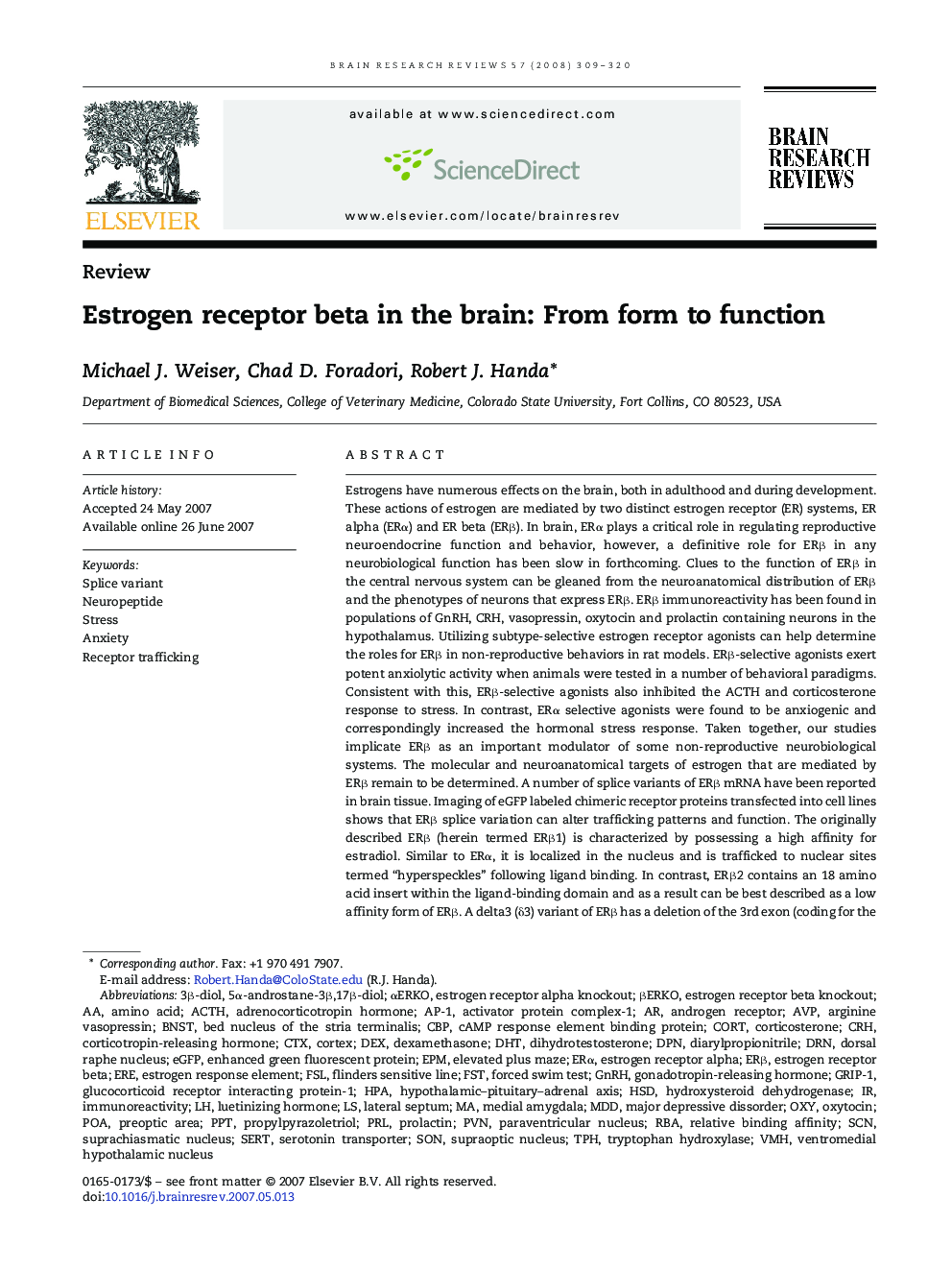| Article ID | Journal | Published Year | Pages | File Type |
|---|---|---|---|---|
| 4333830 | Brain Research Reviews | 2008 | 12 Pages |
Abstract
Estrogens have numerous effects on the brain, both in adulthood and during development. These actions of estrogen are mediated by two distinct estrogen receptor (ER) systems, ER alpha (ERα) and ER beta (ERβ). In brain, ERα plays a critical role in regulating reproductive neuroendocrine function and behavior, however, a definitive role for ERβ in any neurobiological function has been slow in forthcoming. Clues to the function of ERβ in the central nervous system can be gleaned from the neuroanatomical distribution of ERβ and the phenotypes of neurons that express ERβ. ERβ immunoreactivity has been found in populations of GnRH, CRH, vasopressin, oxytocin and prolactin containing neurons in the hypothalamus. Utilizing subtype-selective estrogen receptor agonists can help determine the roles for ERβ in non-reproductive behaviors in rat models. ERβ-selective agonists exert potent anxiolytic activity when animals were tested in a number of behavioral paradigms. Consistent with this, ERβ-selective agonists also inhibited the ACTH and corticosterone response to stress. In contrast, ERα selective agonists were found to be anxiogenic and correspondingly increased the hormonal stress response. Taken together, our studies implicate ERβ as an important modulator of some non-reproductive neurobiological systems. The molecular and neuroanatomical targets of estrogen that are mediated by ERβ remain to be determined. A number of splice variants of ERβ mRNA have been reported in brain tissue. Imaging of eGFP labeled chimeric receptor proteins transfected into cell lines shows that ERβ splice variation can alter trafficking patterns and function. The originally described ERβ (herein termed ERβ1) is characterized by possessing a high affinity for estradiol. Similar to ERα, it is localized in the nucleus and is trafficked to nuclear sites termed “hyperspeckles” following ligand binding. In contrast, ERβ2 contains an 18 amino acid insert within the ligand-binding domain and as a result can be best described as a low affinity form of ERβ. A delta3 (δ3) variant of ERβ has a deletion of the 3rd exon (coding for the second half of the DNA-binding domain) and as a result does not bind an estrogen response element in DNA. δ3 variants are trafficked to a unique low abundance and larger nuclear site following ligand binding. A delta4 (δ4) variant lacks exon 4 and as a result is localized to the cytoplasm. The amount of individual splice variant mRNAs varies depending upon brain region. Examination of neuropeptide promoter regulation by ERβ splice variants demonstrates that ERβ functions as a constitutively active transcription factor. Moreover, it appears that splice variation of ERβ alters its ability to regulate transcription in a promoter-dependent and ligand-dependent fashion.
Keywords
ERβFSTAP-1DRNAVPPRLBNSTCBPTphERαDPNFSLSCNCTXVMHDiarylpropionitrileACTHGnRHGRIP-1RBADHTDEXCRHPOAPPTEREeGFPEPMMDDHSD3β-diol5α-androstane-3β,17β-diolforced swim testmedial amygdalaamino acidStressAnxietyOXYoxytocinImmunoreactivityelevated plus mazeDexamethasoneDihydrotestosteroneSERTserotonin transporterlateral septumestrogen response elementSONFlinders sensitive lineReceptor traffickingCortexPVNhypothalamic–pituitary–adrenal axisPreoptic areaHPANeuropeptidesplice variantSupraoptic nucleusbed nucleus of the stria terminalisdorsal raphe nucleusVentromedial hypothalamic nucleusparaventricular nucleusSuprachiasmatic nucleusadrenocorticotropin hormonecorticotropin-releasing hormoneGonadotropin-releasing hormonehydroxysteroid dehydrogenasetryptophan hydroxylaseRelative binding affinityarginine vasopressincAMP response element binding proteinenhanced green fluorescent proteinProlactinCORTCorticosteroneAndrogen ReceptorEstrogen receptor alphaEstrogen receptor beta
Related Topics
Life Sciences
Neuroscience
Neuroscience (General)
Authors
Michael J. Weiser, Chad D. Foradori, Robert J. Handa,
